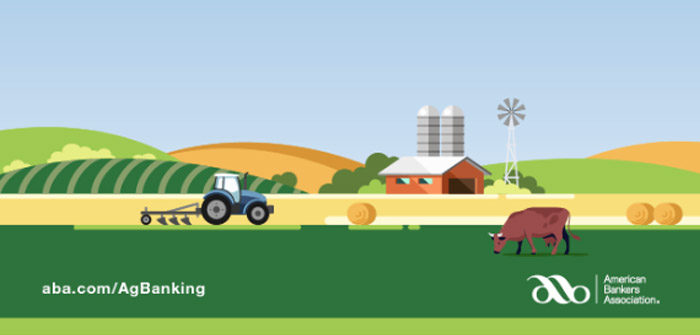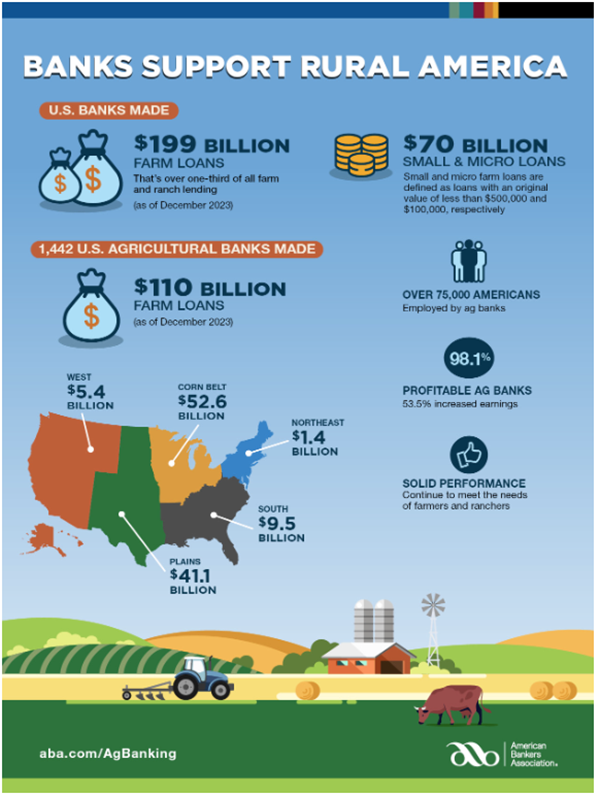(Graphic courtesy of ABA Bankers)
Amid elevated production costs, commodity price volatility and a return to pre-pandemic levels of direct government payments, agricultural loan demand increased in 2023 and agricultural lending by U.S. farm banks grew 6.7% to $110.0 billion, according the American Bankers Association’s annual Farm Bank Performance Report.
“Farm banks continued to enjoy solid performance in 2023, with robust loan growth and historically low delinquency rates,” said ABA’s Chief Economist Sayee Srinivasan. “Moving forward in 2024, the agricultural sector will continue to face challenges due to monetary policy actions targeting persistent inflation in the U.S., as well as reduced federal support. Nevertheless, farm banks maintained their strong asset quality and consistent growth in high-quality capital, and they remain well-positioned to continue serving the needs of their customers and communities.”
The report — an analysis by ABA’s economic research team based on FDIC and USDA data — examines the performance of the nation’s 1,442 banks that specialize in agricultural lending. ABA defines farm banks as banks whose ratio of domestic farm loans to total domestic loans is greater than or equal to the industry average.
The report shows that farm banks are also a major source of credit to small farmers. At the end of 2023 they held 639,694 small farm loans worth more than $44.6 billion, including $9.2 billion in micro farm loans at the end of 2023. A small farm loan is a loan with an original value of $500,000 or less and a micro farm loan is a loan with an original value of $100,000 or less.
In 2023, 98.1% of farm banks were profitable, with 53.5% reporting an increase in earnings. Credit quality at farm banks remained strong in 2023, according to the report. Coming off of historically low delinquency rates, the median noncurrent rate at farm banks (loans 90 days or more past due and loans in nonaccrual status) edged up by just 3 bps to 0.23%. By comparison, the noncurrent loan ratio for the broader banking sector was 0.27%.
While farm banks are typically smaller institutions, they have a large footprint throughout rural America employing about 75,500 workers across 7,253 branches. Employment at farm banks grew by 1.3% in 2023, adding nearly 988 jobs. Since 2013, employment at farm banks has risen 24.4%.
Farm banks have also built strong, high-quality capital reserves and remain liquid and prepared to manage potential economic headwinds. Equity capital at farm banks increased 14.0% to $47.2 billion in 2023, and Tier 1 capital increased by 6.8% to $53.7 billion.
The entire banking industry — not just farm banks — is a critical provider of credit to American farmers and ranchers. At the end of 2023, America’s banks held nearly $199 billion in farm and ranch loans, accounting for about 38% of total outstanding agricultural credit. The U.S. banking industry is also a major source of funding to small farmers. According to the report, banks reported holding over 1.1 million small farm loans worth $70 billion at the end of 2023, including more than 687,000 microloans worth over $15 billion.
“Banks provide much-needed access to credit throughout rural America, but the industry can do even more with the help of Congress,” said Ed Elfmann, senior vice president, agricultural and rural banking policy at ABA. “We strongly support the Access to Credit for our Rural Economy Act, or ACRE Act, a bipartisan bill introduced in both the House and Senate this Congress that will help lower interest rates for rural borrowers. If enacted, ACRE would free up more capital to help farmers and ranchers directly, and it would encourage local farm banks to provide even more sound and productive credit in support of rural communities across the country.”
The Farm Bank Performance Report also provides regional summaries:
- The Northeast region’s 9 farm banks increased farm loans by 8.66% to $1.37 billion in 2023. Ag production loans grew 4.30% from the year before, while farmland loans increased 9.0%.
- The South region’s 139 farm banks increased farm loans by 9.78% to $9.52 billion in 2023. Ag production loans grew 12.0% from the year before, while farmland loans increased by 9.02%.
- The Cornbelt region’s 681 farm banks increased farm loans by 25.7% to $52.6 billion in 2023. Ag production loans grew 8.90% from the year before, while farmland increased rose by 5.7%.
- The Plains region’s 572 farm banks increased their farm loans by 9.42% to $41.1 billion in 2023. Ag production loans grew 14.53% from the year before, while farmland loans increased 5.12%.
- The West region’s 42 farm banks increased their farm loans by 6.66% to $5.42 billion in 2023. Ag production loans grew 9.79% from the year before, while farmland loans increased 4.53%.
Read the 2023 Farm Bank Performance Report.
See ABA’s infographic summarizing the report.
About the American Bankers Association:
The American Bankers Association is the voice of the nation’s $23.7 trillion banking industry, which is composed of small, regional and large banks that together employ approximately 2.1 million people, safeguard $18.8 trillion in deposits and extend $12.5 trillion in loans.



